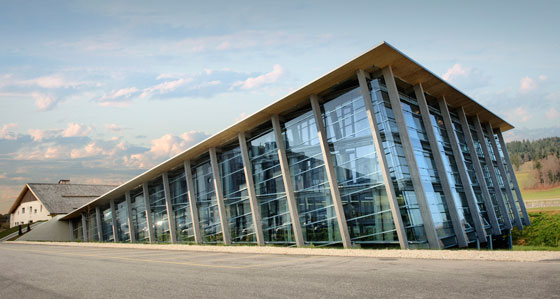
From CompliTime, dedicated to the development of complicated movements, to the manufacture which this year celebrates its tenth anniversary, a unique adventure.
Founded in 2004, Greubel Forsey this year celebrates its tenth anniversary. Occupying a high-tech building in la Chaux-de-Fonds, the firm’s workshops employ nearly 120 people and produce around a hundred exceptional timepieces each year.
An impressive number of patented inventions and extraordinary creations - honoured on several occasions by prestigious awards – are a glowing testimony to this first decade of existence. The signature created by Robert Greubel and Stephen Forsey has become a rallying call for many discerning enthusiasts. Meanwhile watch industry players agree that the company is at the top of its game after only ten years of existence. They applaud a philosophy which accords meticulous attention to every detail, as well as an artistic dimension which continues to grow in stature with the input of multiple designers.
Two devotees create two firms
Born in Alsace, Robert Greubel very quickly discovered a flair for precision engineering. During his childhood he spent long hours watching his father, a watchmaker, before starting work himself in the family business «Greubel Horlogerie». A fan of complicated movements, he moved in 1987 to Schaffhouse in Switzerland, where he collaborated on IWC’s grand complications project. From 1990 he worked as a prototypist in Le Locle with Renaud & Papi, later becoming co-director and partner of the firm. In 1999, he chose independence, and in 2001, with Stephen Forsey, founded the company CompliTime with the aim of designing and developing complicated mechanisms for leading brands.
Born in St. Albans in England, Stephen Forsey inherited a strong interest in complex mechanisms from his father. From 1987, he specialised in the restoration of old clocks and became head of the watch restoration department at Asprey, in London, before completing his training at WOSTEP (watchmaking training centre). In 1992, he moved to Switzerland and joined Robert Greubel’s team at Renaud & Papi, where he worked on the most complicated movements. In 1999, he too became self-employed and, two years later, embarked on the adventure with Robert Greubel.
Relying on their experience as designers of complicated movements, the two watchmakers established the Greubel Forsey company in 2004. At Baselworld that year they presented their first invention, the Double Tourbillon 30°. The launch, which proved a huge success, encouraged them to waste no time in developing a highly selective global distribution network.
Spurred on by this initial success, the two watchmakers gave free rein to their creativity. Technical inventiveness and revolutionary architecture characterise each of their timepieces. The heart of the mechanism is systematically theatricalised, showcasing a bold aesthetic approach perfectly in keeping with the technical concept. This twofold creativity (technical and artistic) allows certain pieces to be improved and developed in original ways, such as the tourbillon, which had scarcely evolved since the golden age of watchmaking in the late 18th century.
Robert Greubel and Stephen Forsey are not content simply to reinterpret primary mechanisms. They also devise new ways of presenting traditional complications, for example with the GMT model. The architecture of horology adapts readily to an asymmetrical vision, while certain components can add an extremely contemporary touch. Over the years, this aesthetic and essentially artistic dimension has come to form a major part of the DNA of their creations.
Throughout the past decade, Greubel Forsey has continued to develop and launch new and revolutionary models. In 2005 the brand presented the Quadruple Tourbillon, in which four tourbillons are connected to a spherical differential. The final version of this model was unveiled in 2008 at Baselworld. The year 2006 was also marked by major innovations, not least the Tourbillon 24 Secondes, whose patented mechanism exploits the benefits of rapid rotation of a single, inclined tourbillon cage. Greubel Forsey also collaborated with Harry Winston to produce the Opus 6. The fruit of a meeting with artist Willard Wigan, the Art Piece 1 was unveiled in 2012 at the Salon International de la Haute Horlogerie (SIHH). A designer of microscopic sculptures, this British artist sculpts gold, hair and grains of rice on a minute scale. One of his works has been featured on a Greubel Forsey timepiece. This development represented a major technical challenge. Indeed a mini-microscope was incorporated in the crown to provide in excess of 20x magnification. Peering through this miniature lens is the only way the Willard Wigan sculpture can be admired.
The complexity and precision of Greubel Forsey timepieces have won many awards for the manufacture based in La Chaux-de-Fonds: in 2007, the Tourbillon 24 Secondes won the Watch of the Year special jury prize; in 2009, the Double Tourbillon 30° Technique won the Grand Prix d’Horlogerie de Genève (GPHG) and also the International Chronometry Contest in 2011; the Double Tourbillon 30° Edition Historique for its part was voted Best Watch of the Year 2010, again at the GPHG. The two founders were also singled out in 2009 to receive the Gaia Award, presented by the International Museum of Horology.
October 23, 2014


 News
News